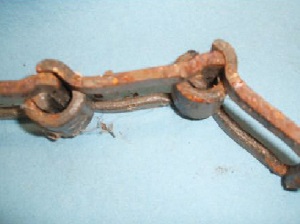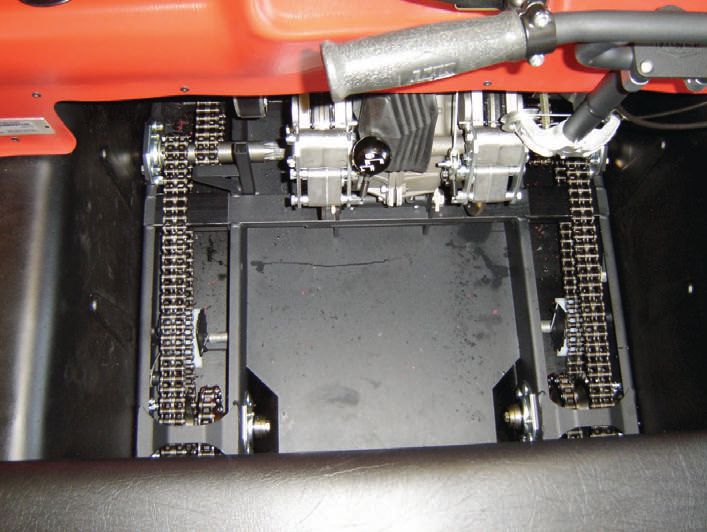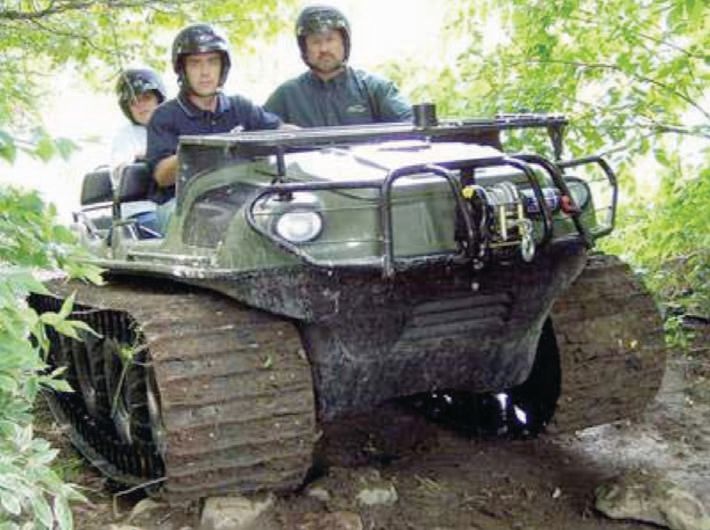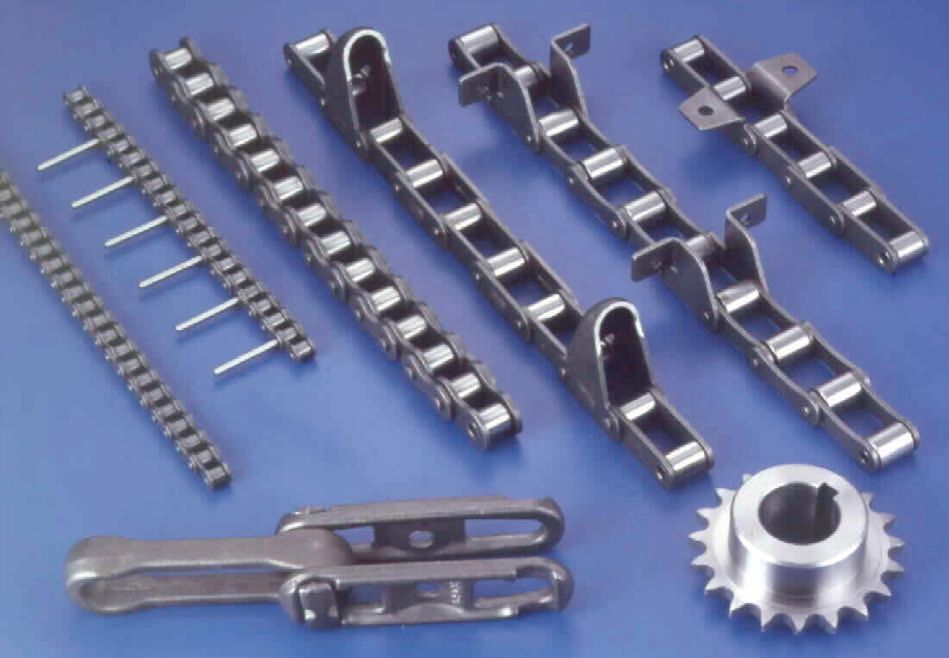Chains, Chains, Oh, These Heavy Chains
Dr. Robert M. Gresham, Contributing Editor | TLT Lubrication Fundamentals August 2013
When it comes to sound lubrication practices, these simple mechanisms often are the weak link in a conveyer system.
KEY CONCEPTS
•
Chains are widely used in industry and transportation in applications where belts are inappropriate such as drive mechanism.
•
Lubrication of chain conveyors is as much a part of reliability-centered maintenance as any other critical aspect of the operations.
•
To keep chains from failing from the inside, the lubricant must penetrate the rollers, pins and bushings to lubricate the load-bearing surfaces.
DOES THE HEADLINE OF THIS ARTICLE SOUND LIKE CHARLES DICKENS’ GHOST of Jacob Marley? In a previous TLT article, I discussed, among other things, lubricating chains on a manure spreader. Chains for those mechanisms are inexpensive metal stampings with relatively sharp edges that preclude coatings and most lubricants from protecting them from corrosion. Further, the bearing surfaces are rough, adding to friction and wear. On the positive side, they are inexpensive, no, cheap (
see Figure 1).
 Figure 1.
Figure 1.
These chains have another remarkable property—they only seem to break at below 20 F (-28.8 C), especially if it is windy and snowing. As time goes on, constant exposure to the elements, manure, urine and wet bedding eventually corrode and weaken the chain. The stresses of winter, frozen “payload,” ice, etc., put more strain on the chain, increasing the probability of failure.
Repair is simple enough: the tension on the chain is released, the chain is bent into position where, with just a few light taps of a hammer, the old link is removed and the new one installed. This repair, of course, happens only in the field, only on cold, windy, snowy days—hopefully during daylight. The manure must first be dug out of the spreader by hand to access the chain. The light taps of the hammer are actually a bare-handed, knuckle-busting, expletive-deleted operation taking “only a few seconds.” Yeah, right!
INDUSTRIAL APPLICATIONS
Well, chains for manure spreaders are at the low end of the food chain of chains. Indeed, chains are widely used in industry and transportation in applications where belts are inappropriate such as drive mechanisms. Their usage ranges from the most common, the everyday bicycle chain, up to more sophisticated applications such as the Avenger 750, an all-terrain amphibious vehicle (
see photos).
 Avenger 750 EFI Drive chains
Avenger 750 EFI Drive chains
 Avenger 705 All Terrain
Avenger 705 All Terrain
In the industrial world, to a very large extent, chains are used in conveyor mechanisms. Examples are paint line conveyors and related assembly line conveyors. Conveyors also are used in meat-packing plants carrying many tons of sides of beef through various processing steps.
Chains in industry are ubiquitous, come in many varieties and serve in many environments. Chains must function under extreme loads such in a John Deere or Caterpillar plant carrying huge pieces of off-road equipment in various stages of assembly. In these plants, the payload may be conveyed through a variety of process steps—cleaning washers, paint lines, ovens, etc.—where the opportunity for contamination from dust, dirt and chemicals is to be expected, and the extremes of temperature can run from cryogenic to high-temperature kilns.
These more advanced design chains in their own right are pretty sophisticated mechanical systems. They come in many sizes, shapes and designs, with any of a number of specialized appendages for hanging things from them. These chains also must accommodate the drive mechanism that propels them and the guide mechanisms that allow the chains to rise, fall, turn, etc., to accommodate the floor plan of the plant and the process equipment. Roller chains fill most of these needs.
As opposed to their manure-spreading country cousin, industrial chains are relatively precise in the materials of construction and equally precise in the dimensional design and manufacture requirements. The rollers of such chains are truly bearing surfaces. How is the lubrication engineer to lubricate such chains?
As you might guess, the answer is neither easy nor simple. In my experience, especially in manufacturing environments, chain conveyors often are the forgotten child in industrial plants. All too frequently the lubricators, installed by the manufacturers and installers of the conveyor, are allowed to run too fast, dripping all over the place and contaminating the payload. Or they operate too slowly, starving the bearing surface, or they just run empty. Often they are charged with waste oil or the wrong oil or, gee, not even turned on.
And where do you think blame is laid when chain-related problems arise form poor lubrication practices? The chain supplier/designer is no good. And if savaging the chain supplier doesn’t work, there is always the lubricant supplier—always an easy, fun target to divert blame and accountability. Who knows, maybe we can get him to take us to dinner to keep the business. Been there?
Taking the higher road, lubricants, assuming they are used properly, need special thought by the lubricant supplier, conveyor supplier and the end-user’s maintenance and operations departments. Lubrication of chain conveyors is as much a part of reliability- centered maintenance as any other critical aspect of the operations.
Chains most commonly fail from the inside; that is, the lubricant must penetrate the rollers, pins and bushings of the chain to lubricate the load-bearing surfaces. In addition, as a consequence of penetration, the lubricant should wash out and seal out contaminants, which can be dust, dirt, chemicals or just about anything. The lubricant formulator might have a difficult job as the chain could move slowly with high loads, implying extreme boundary and mixed lubrication regimes. This implies the need for higher viscosity base oils, which inherently might not penetrate as well as desired. Use of solvent carriers can aid in penetration but must evaporate rapidly to leave a thick film. Additives like solid lubricants and EP and antiwear additives can help.
 Chains come in many sizes, shapes and designs, with any of a number of specialized appendages.
Chains come in many sizes, shapes and designs, with any of a number of specialized appendages.
The chain’s operating environment affects the choice of oils and additives that can be used to combat highly corrosive and/or wide temperature extremes. Further, especially in food applications, the oils and additives may be restricted by regulation. Or the lubricant may need to displace water or steam as found in some food processing or paper mills.
Once again, “How is the lubrication engineer to lubricate such chains?” These chains can be a heavy load, indeed, making the poor lonely lubrication engineer feel like Marley’s ghost. Clearly, a team approach is needed between lubrication engineer, conveyor supplier, lubricant supplier and the operations and maintenance departments.
First and foremost, however, make sure the lubricator is turned on and working properly before picking up the phone.
 Bob Gresham is STLE’s director of professional development. You can reach him at rgresham@stle.org
Bob Gresham is STLE’s director of professional development. You can reach him at rgresham@stle.org.